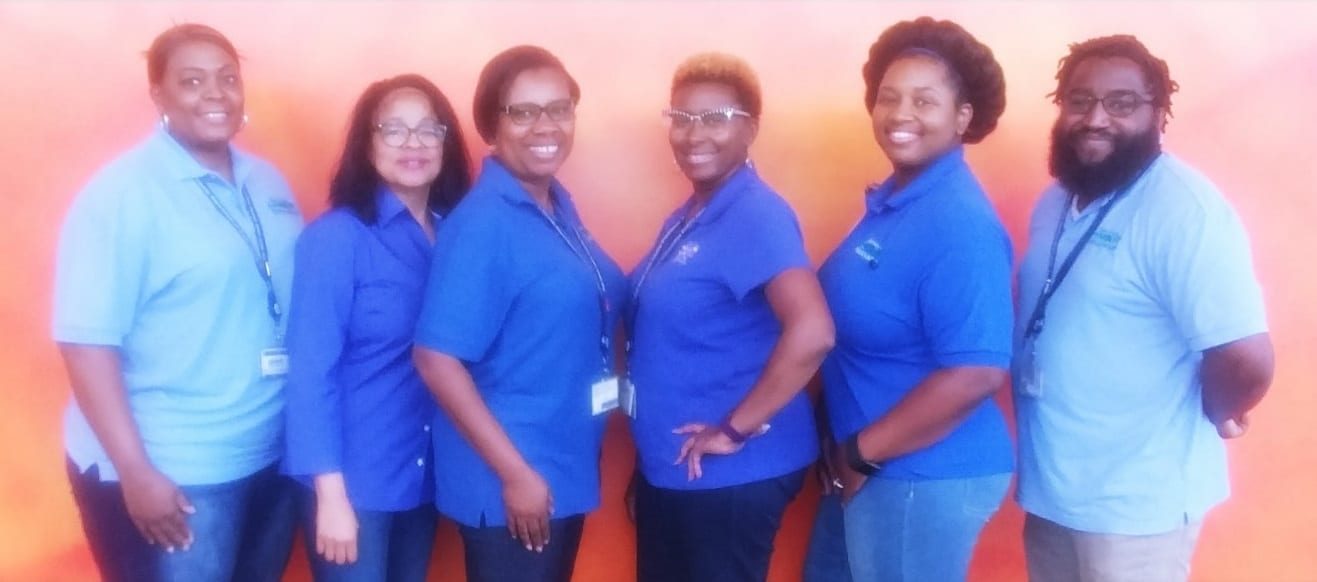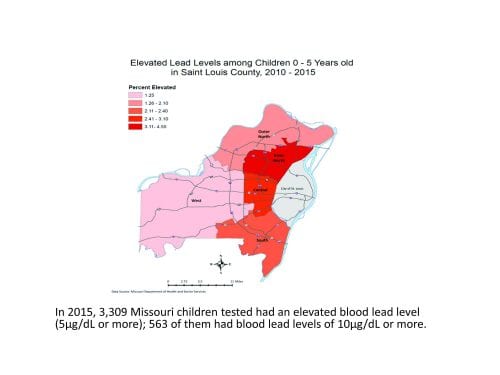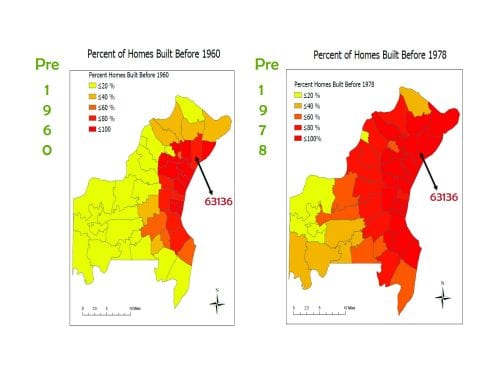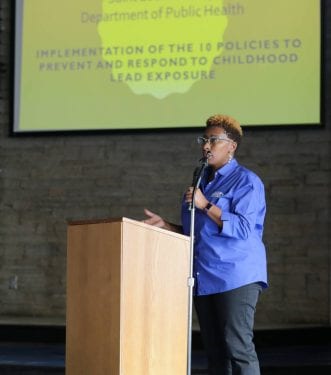Implementing a Successful Lead Mini-Grant Award
Note: This is the second of a series of mini-grant awardee blogs for National Lead Poisoning Prevention Week. You may also be interested in parts one, three, and four.
by Joyce Theard, St. Louis County Department of Public Health
Congratulations on receiving a National Center for Healthy Housing (NCHH) lead poisoning prevention awareness community mini-grant! All of your hard work has paid off. Now the fun begins… It’s time to execute your plan for the lead awareness event.
Perhaps you thought it was stressful applying for the grant and meeting the timeline. Nonetheless, you did it. Implementing the event has a short turnaround as well, but it can be easier to do. The key to your success begins with using the right resources, your community partners, and a supportive team behind you.
As a local public health agency, we’re in the business of promoting public health events. This event is no different – just different community partners and health message.
First, review your goals: What is it you’re trying to do? What tools and best practices are available to assist you? When are you doing it? How are you going to do it? What will be your measure of success? These are things to consider before you implement your plan.
Resources
Let’s start with the public health message. If you’re promoting a national event, resources are readily available to assist you. For example, the Centers for Disease Control and Prevention (CDC) offer a Lead Poisoning Prevention Week tool kit to assist state and local agencies. CDC partners with other federal agencies to provide educational materials and activities to help you reach your goal.
NCHH is another resource that provides technical assistance. They can help with the planning and implementation of your event. From sample press releases to PowerPoint presentations and outreach materials, their website provides you with a plethora of information. For example, NCHH’s site contains many best practices, including a link to 10 Policies to Prevent and Respond to Childhood Lead Exposure to support your lead poisoning prevention strategy.
For local and regional data, your state health department can be a source of valuable information too. They’re able to share strategies that are currently working in your community and refer you to regional partners. The state’s website often has materials available for downloading and provides reports to help you identify a target population. Our state’s data helped us determine the high-risk population in the county and areas that were disproportionately affected by lead.
Another resource can be your local planning department. They can provide assistance with identifying pre-1978 housing stock in the community. After consulting with them, we were able to create a GIS map of the targeted population and the pre-1978 housing stock. What a great visual to have to support your strategy!
Community Partners
After reviewing state and local lead data and national resources, think about your community partners: Who else has a vested interest in the target population? For us, collaborating with the local school district and municipality was the best option. Together, we played a vital role providing service to the community.
We decided to collaborate with Jennings School District and the City of Jennings to celebrate National Lead Poisoning Prevention Week. A lead screening event and “Lunch ‘n’ Learn” stakeholder meeting were planned. The goals were to:
- Increase knowledge among parents attending the event.
- Increase awareness among decision makers on lead poisoning prevention.
- Increase the practice of lead screening in the targeted population.
- Strengthen partnership between Jennings and the St. Louis County Department of Public Health (DPH).
Promoting the Event
To promote lead poisoning prevention and increase public awareness we worked closely with our communications team. We printed flyers announcing the event and posted them around the community. We also sent flyers to parents of the children at the child care centers and school and to the municipality.
We sent press releases to several local media outlets. As a result, the DPH conducted a local television interview and an onsite interview the day of the event with St. Louis Public Radio. In addition, we participated in a Twitter chat hosted by NCHH (#NLPPWchat) for National Lead Poisoning Prevention Week and shared information about the work we do in the community. Our media coverage and event promotion efforts proved to be a great success.
Implementation and Evaluation
The day arrived to implement our plan… We designated the morning for the lead screening event. The “Lunch ‘n’ Learn” with the stakeholders was scheduled for noon. There was good representation from parents, city, and school district personnel in attendance. We also administered a pre- and post-test before and after the meeting to assess their knowledge of lead poisoning prevention.
Whew! The event is over. We can now breathe a sigh of relief… So, how successful were we? Did we reach our goal? Our assessment tools revealed the following outcomes:
Goal 1: Increase knowledge among parents attending the lead presentation.
Our pre-test found that only 44% of the participants were very confident identifying who’s at risk and the effects of lead poisoning. According to the post-test, 100% of the participants were very confident in their understanding after the event, resulting in a successful increase in knowledge.
What we learned: While we were completely successful in our efforts to educate the participants who attended, we expected greater representation from the parents. The event was held in the afternoon, which may have limited how many parents were able to attend.
Goal 2: Increase awareness among decision makers on lead poisoning prevention.
Thirty community stakeholders attended. Prior to our event, only 31% of decision makers considered themselves very confident identifying lead sources and ways to minimize their risks. The post-test found that 100% of the attendees were very confident after attending the “Lunch ‘n’ Learn” presentation.
What we learned: Officials at the highest levels of local government and school district personnel made up half of the attendees. While many parents couldn’t attend due to the timing of the event, the timing worked out very well for the decision makers, and we were able to educate all who attended. This group of the population is as important to our cause as the parents. In the future, it may make sense to vary our event times and locations until we determine what the best time for both stakeholders and parents is.
Goal 3: Increased practice of lead screening in the target population.
Screenings were held at three childhood center sites. Of the 50 children that were eligible to be tested at the early childhood program, 32 were screened for lead, and one test detected an “EBL,” or an elevated blood lead level in one of the children. This established baseline numbers for the Early Childhood Program.
What we learned: Our goal was to test a minimum of 50 children. Because our tests revealed an EBL, it underscored the importance of our outreach activities. However, we fell short of the target we’d set, not because of a problem with our outreach but because parents had not signed a consent form prior to the event. In the future, we’ll offer the lead screening at times when the parents are off work: This way, they can complete the consent form on site, during the event.
Goal 4: Strengthen partnership between the health department and the City of Jennings/Jennings School District.
We enhanced our relationship as a community resource with local government, school district officials, and parents. The City of Jennings invited us to share lead education materials and resources at their upcoming “Make Home Ownership a Reality” workshop (held December 1, 2017), another opportunity to educate the community about lead. We were also invited by Jennings School District to conduct lead screenings at the annual back-to-school fair for 2018.
What we learned: Overall, our efforts were very successful, so the important thing for us is to keep checking in with the city and the school district to find more opportunities to partner in the future.
Finally, the report writing: Every funder wants to see how their money was used and if the investment was worth it. Your outcomes and measurable indicators will help to showcase your level of success. Use this time to document what went well and the challenges you faced. If you had to host the event again, what would you do differently? These are important points to consider when applying for future grant opportunities and will help you to plan for a successful outcome. Maintain copies of your report. You never know when a grant opportunity will present itself and you’ll be ready to GO!
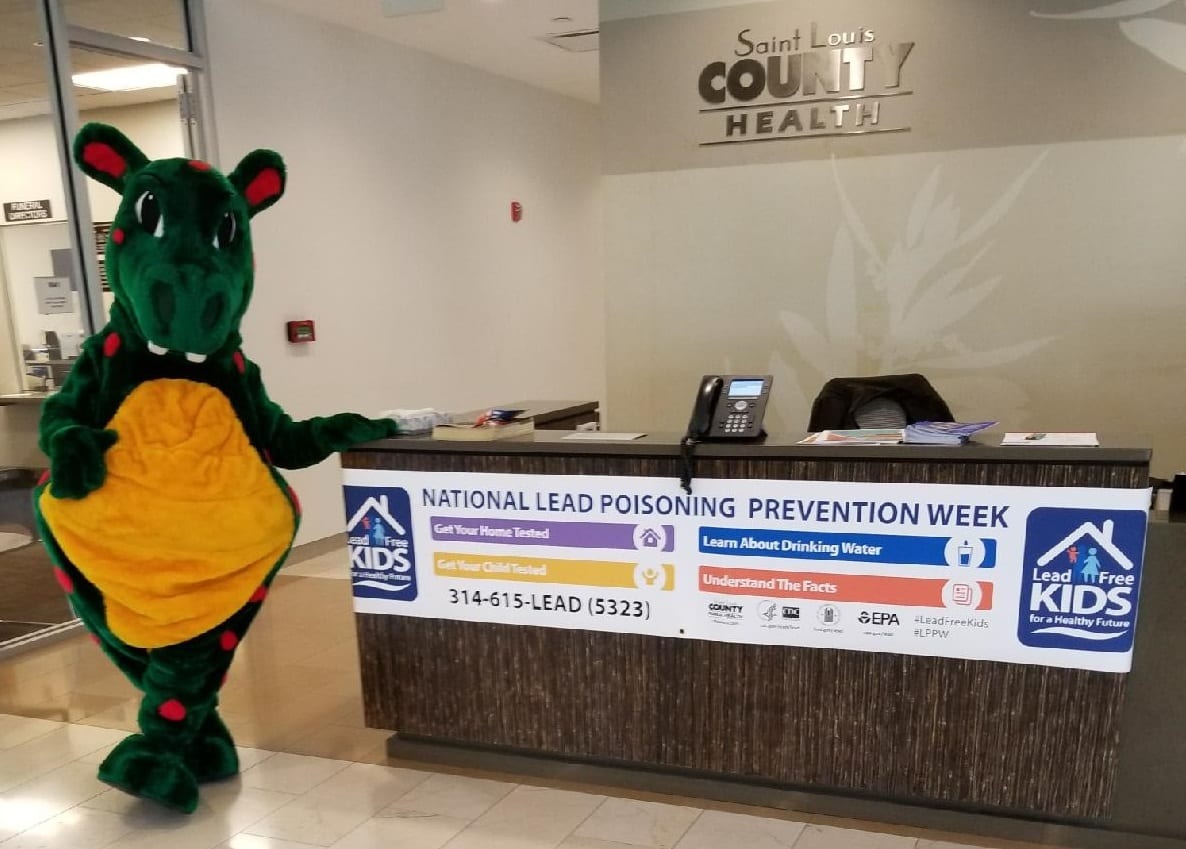
The Leadosaurus posing with St. Louis County’s National Lead Poisoning Prevention Week display. The Leadosaurus, nicknamed “Libby” by the St. Louis staff, was created with funds from the CDC. Download Be Alert! Lead Can Hurt!, a coloring book starring the Leadosaurus, here.
Joyce Theard, MPA, REHS, is the Assistant Director of Environmental Services at the St. Louis County Department of Public Health. She manages the Healthy Homes Program and state contract programs such as child care, lodging, and dairy control to ensure compliance with health and safety codes. Ms. Theard has 30 years of experience in the environmental/public health field. Prior to joining the St. Louis Department of Public Health, she spent 17 years working for public health agencies in the San Francisco Bay area. Her experience in the environmental health field includes retail food safety, public water recreation facilities, hazardous materials, and other environmental programs. Through these programs, Ms. Theard has gained valuable experience establishing and maintaining effective working relationships with the public, community organizations, and local, state, and federal government agencies. Ms. Theard earned a Bachelor of Science degree in health education from Truman State University and holds a Masters in Public Administration from California State University East Bay. She is a Registered Environmental Health Specialist and a member of the National Environmental Health Association. She and her team received an NCHH mini-grant in 2017.
